OPTIONS FOR BETTER HEADPHONE SOUND: Working from home can be a blessing and a curse at the same time. Fortunately, a dash of music can tilt the balance in the right direction. But do you really have to hear your favorite tracks being mutilated by the laptop speakers while working? Not at all. In this article, we look at three low-cost devices that let you listen to your wired headphones in higher quality: the EarMen Sparrow, the EarMen TR-Amp and the Lotoo PAW-S1. A nice bonus is that each one is quite small. And that is quite useful if you have to work and study at a modest desk (from home).
In this article we look at three very affordable devices, two from the Serbian / American EarMen (a spin-off from Milomir Trosic from Auris Audio) and one from the Chinese Lotoo. They promise to provide you with better sound quality when listening through headphones or earphones, on the go, or while working at your desk. Whether at home or at the office.
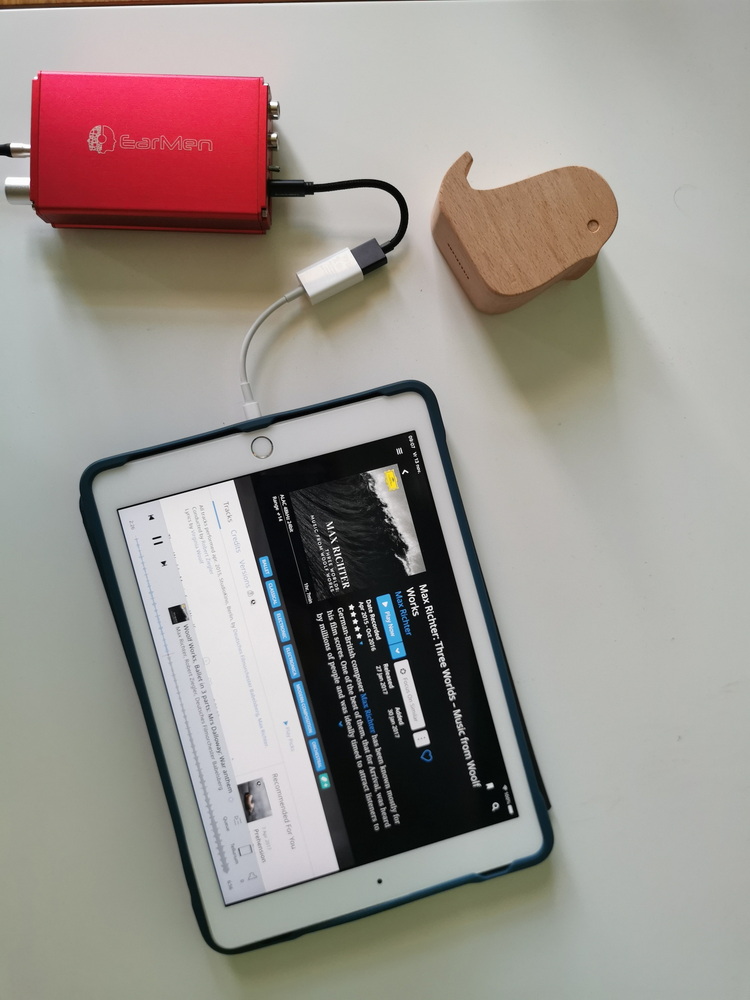
Difficult to use? Not really. In most cases they work plug ‘n’ play: plug in and listen. You hang them on your laptop, tablet or smartphone via a USB cable. They come with their own headphone jack to which you connect headphones or earphones. In any case, they immediately work with Android smartphones and tablets, and with MacOS computers. Connecting to a Windows device is also hassle-free, although you may need an extra driver to listen to hi-res files if you are running an older version of Windows. Finally, all three also work in combination with an iPhone or iPad, provided you purchase the right cable.
What exactly do they do?
The Lotoo PAW-S1 and the EarMen TR-Amp and Sparrow are all three so-called combined DACs (which convert the digital music stream to analog in a better quality) and amplifiers (so that the audio signal is sufficiently amplified so that your headphones can perform loudly and well) . The devices offer a double improvement over the headphone output that is standard on your laptop or mobile device: they process digital files better (including hi-res material) and come with an amplifier section that is powerful and not disturbed by the adjacent electronics. in your computer.
So all three do roughly the same thing, but you cannot just compare them. They each have their advantages and scenarios that they better suit.
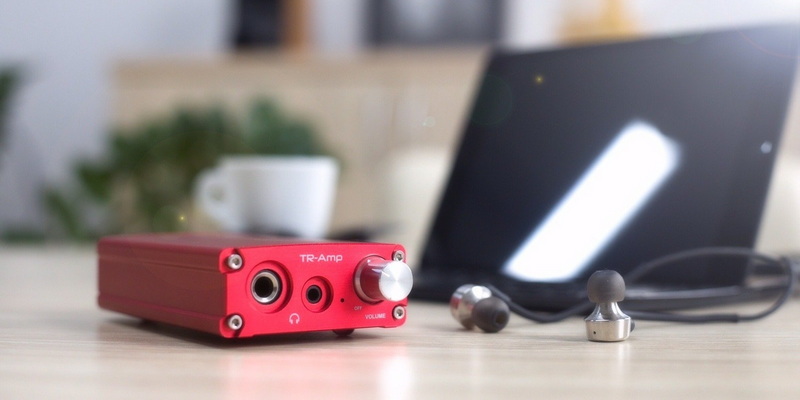
In this article we will mainly talk about listening to music, but a small DAC / amplifier is also useful at other times. If you watch a movie on your laptop via Netflix, for example, or play games. In those cases too, your headphones are better controlled and you therefore get better sound. In stereo, we immediately add for those demanding gamers. If you want to do surround, you should rather look towards a gaming headset.
What are the differences?
The EarMen Sparrow is a very compact device – really tiny, smaller than a matchbox – that gives you a handy way to get much better sound from your smartphone without suddenly having to carry half a brick. It is still something ‘extra’ that you have to take with you, yes, but it is small enough that it does not become a nuisance. It can hardly be more minimalist.
The Lotoo PAW-S1 pictured below is a device about the size of a modal USB stick. Slightly larger and more striking, but still modest and easy to transport. You can of course also connect it to your regular workstation with your PC. The difference with the Sparrow is that the Lotoo-DAC / amplifier has its own display and you can quickly adjust the sound via buttons.
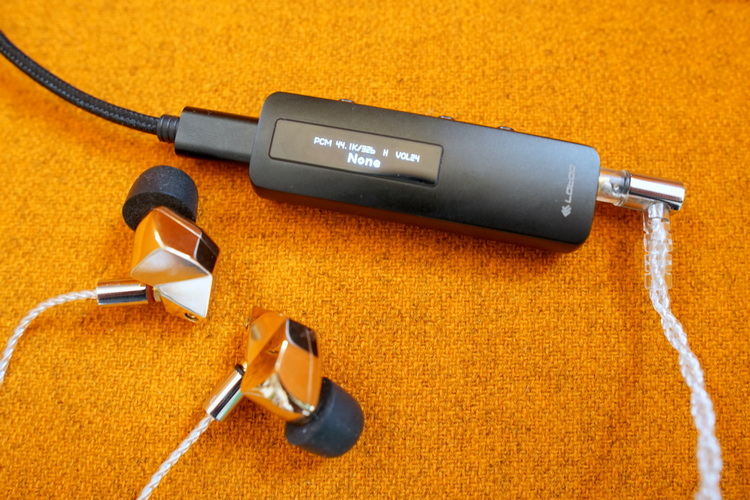
Finally, the EarMen TR-Amp is a larger device. The two other devices get their power from the mobile device they are connected to, the TR-Amp requires a separate USB cable in addition to the cable through which the music is delivered. But it does have a battery, so you can also work without a power cable. The battery is also interesting for desktop use, because the DAC is not affected by noise on the USB line. That sounds cumbersome, but is more common with better DAC / amplifiers for headphones.
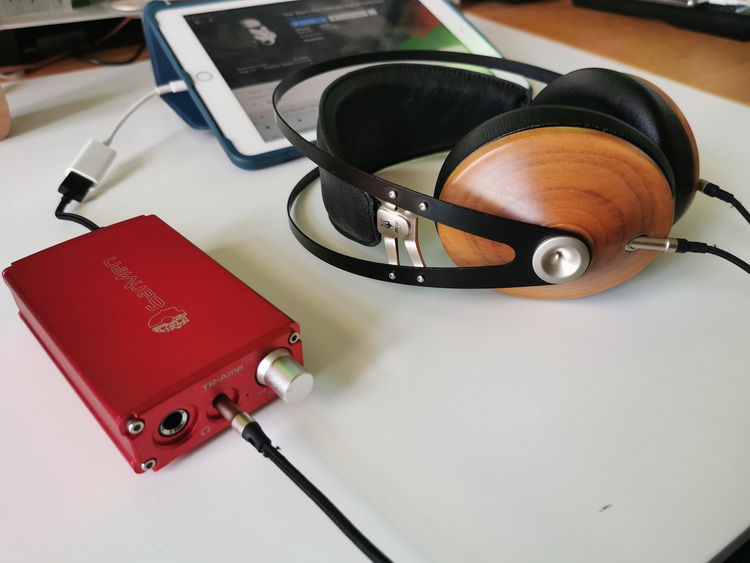
In this way, manufacturers want to prevent the power supply from disrupting the music flow. This gives the TR-Amp more power to control more difficult headphones correctly. In any case, this is really a device to connect to a laptop or desktop PC. It can be linked to a mobile device, but its biotope seems more like your desk at your PC.
There is also something special going on with the EarMen TR-Amp. Importer Dune Blue bundles a beautiful red edition of this device with a beautiful Meze Classic 99 headphones , and offers the package for a special price. We have already looked at the Meze separately, it is a handsome closed headphone with driver housings made of beautifully finished wood and a very successful sound. Not only is it one of the most stylish you can get at this price point, it is also simply excellent closed-back headphones.
We don’t really want to compare the DAC / amps in this article, because we don’t think that makes much sense. But to keep it fairer, we make sure we definitely use the Meze headphones with all three, in addition to devices that we grabbed at certain times because we felt like it. For example, the Philips Fidelio X3 (with a 2.5mm balanced cable) and the FiiO FA7 earbuds.
Just about cables
In most cases, manufacturers of these types of devices provide the cables you need to attach a DAC / amplifier to your mobile device or computer. This always involves a USB cable. But because the world of consumer electronics can never suppress the tendency to be needlessly complex, chances are you won’t get the right cable with your DAC anyway. What are the possible scenarios?
A recent smartphone, tablet or (more expensive) laptop has a USB-C port to which you can connect a DAC / amplifier. The devices we review here (and other products from the past year) are new devices and all come with a cable of this type (USB-C to USB-C).
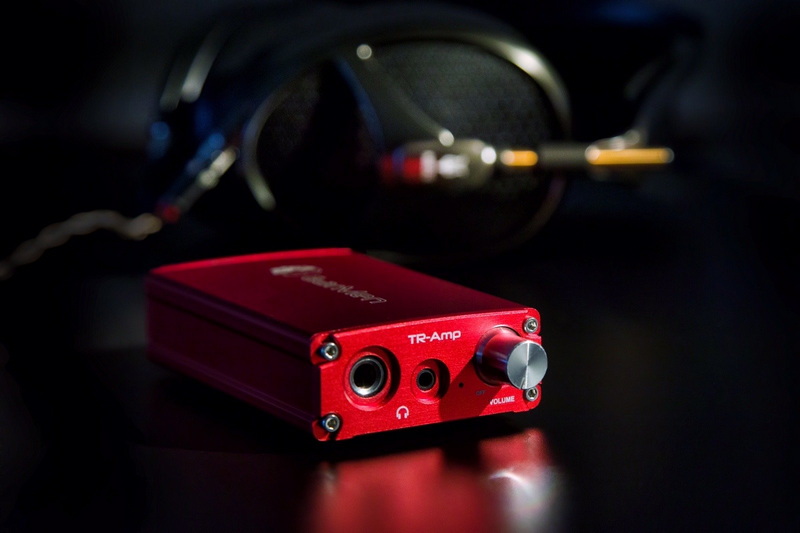
Do you have an iPhone or iPad? Then you have to purchase a suitable cable separately with a Lightning plug. After all, Apple requires manufacturers who make such a cable to install a special chip and that costs (relatively) a lot. At Apple you pay about 39 euros for it, there are also other manufacturers.
In any case, with low-cost devices, you will rarely find an Apple cable in the box.
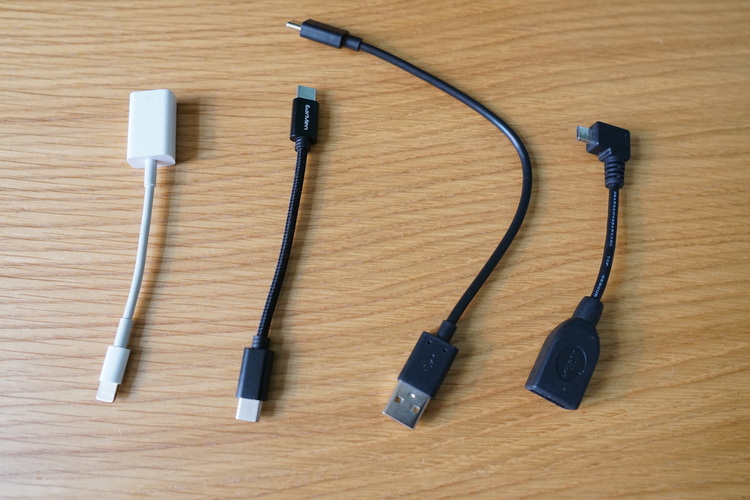
Do you own a laptop without USB-C or a desktop PC with only USB class A ports? Then there is a good chance that there is a suitable adapter or cable in the box (a rectangular class A to the oval class C). Otherwise, you’ll have to buy a USB-C cable. Note: some cheap USB-C cables only carry power (for charging), and not the data you need to listen to music.
Still own a smartphone or tablet with a trapezoidal micro USB port? You then need a USB Host cable, with a small micro USB plug on one end and a female USB-A on the other. You plug the USB cable of your DAC into this.
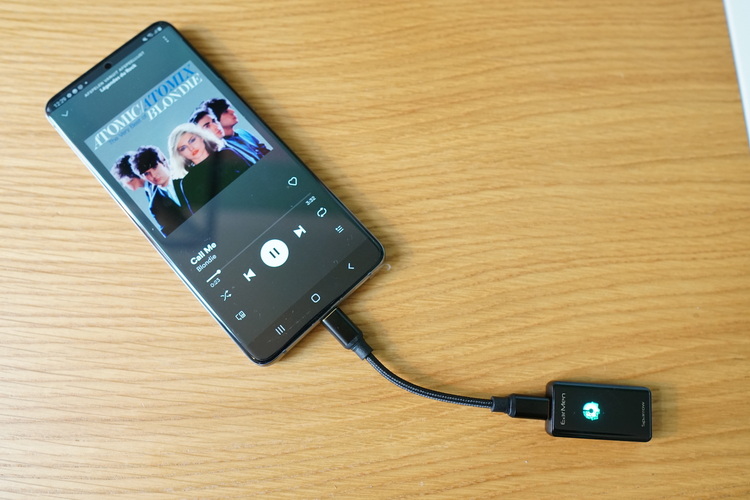
We tested the three devices – sometimes long, sometimes short – with an iPad, a Surface Pro with Windows 10, an iMac 27-inch with MacOS and a Huawei P30 Pro. We have thus covered the four major software platforms; all three worked flawlessly with each. There is one more way to use these devices: with a suitable music player or DAP. A little one like the Shanling M0 combined with a compact DAC / amplifier gives you a nice music system on the go that lets you listen without being disturbed by Whatsapp and Instagram notifications. A bit of peace in the hectic, as it were.
Hi-res: what is it and where can I find it?
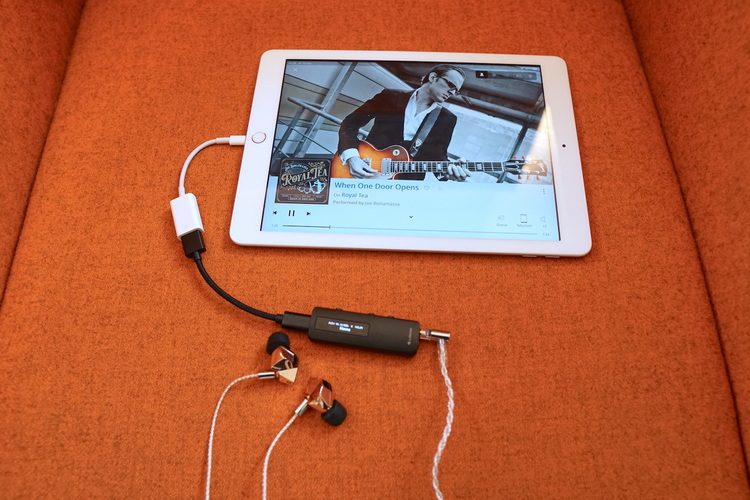
A special gift of devices as we are looking at here is that in addition to compressed audio (such as MP3s or AAC files) and files in CD quality (wrapped in WAVs, FLACs or ALACs, for example), they can also play hi-res music. Is that important? If your main source of music is Spotify or Apple Music, or you are listening to a large collection of music files purchased from the iTunes Store, the answer is “No”.
However, if you have a subscription with Qobuz or Tidal and / or you also own music files in hi-res quality (24-bit / 96 kHz for example), the answer is: “Yes”. (For the sake of completeness, a DAC does not decode MP3s, FLACs or other music files. Your PC or smartphone does that, which then forwards an audio stream to the DAC).
At the same time, the above discussion is completely superfluous. If you buy a DAC these days, it will handle hi-res material. And of course also lower quality levels.
The only question is whether a DAC can handle very exotic quality levels, such as PCM files of 32-bit / 384 kHz or DSD streams for example. Again, that question is only relevant for some (not that many people listen to it because there isn’t much material in those formats), but in this case you shouldn’t really be concerned about it. After all, the surprising thing about the three devices that we are looking at here is that they can handle almost any format. Even DSD128. And that while the most expensive device taps at 279 euros. It just goes to show that (entry-level) DAC chips have now become very accessible for manufacturers.
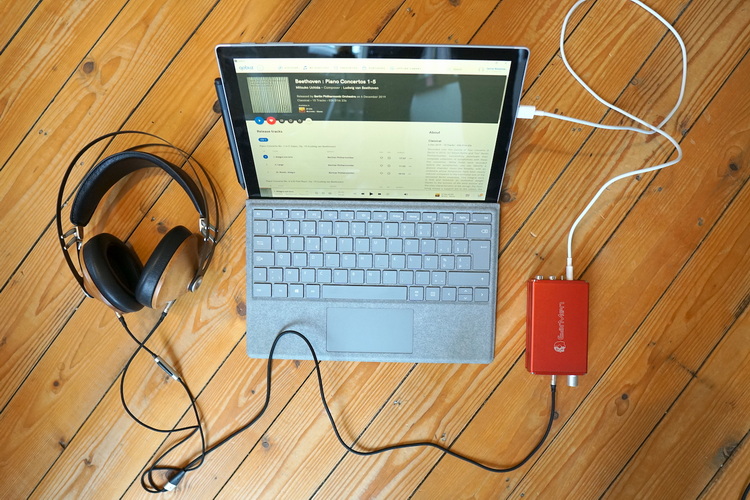
The two EarMens do have an asset for audiophiles that the Lotoo does not have: MQA rendering, thanks to the use of a new ESS chip. This technique for hiding hi-res material in more compact files is mainly used by Tidal, although you can also find MQA files on Qobuz and via download stores such as 2L. If you listen a lot on your mobile via 4G and you have a preference for hi-res, then that is good to know. At home with a decent broadband subscription, you shouldn’t worry about the size of your hi-res material.
A lego male big
Whatever else the EarMen Sparrow may be, it is above all a miracle of miniaturization. It’s so small that it even fits into that tiny inner pocket in your jeans pocket that you’ve wondered what it’s for all your life. On the grand scale of far-fetched size comparisons, it is a “lego male.” The Sparrow is also very light. If it hangs on your smartphone with an included mini cable, you hardly notice it. The box also contains a cable to connect it to a PC.
The 219-euro Sparrow contains the ES9281PRO, which is actually a better DAC chip from ESS. It features a regular 3.5mm jack as well as a 2.5mm jack for a more powerful balanced connection.
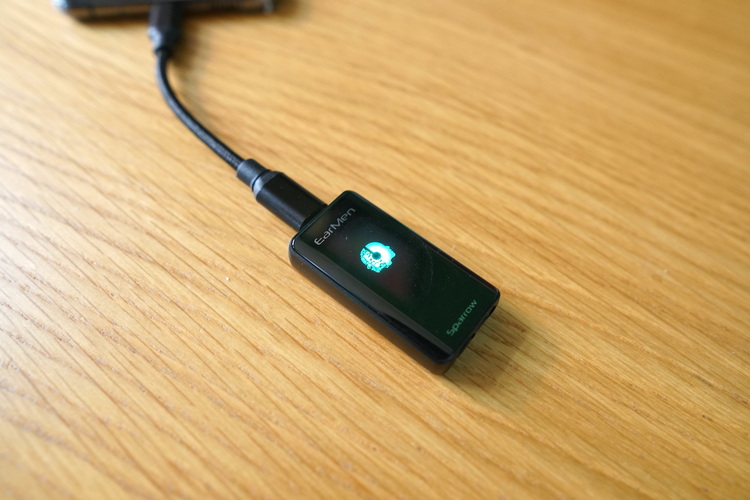
The Sparrow has no volume buttons. If we hang it on a Huawei P30 Pro or iPad, that’s no problem. We just use the buttons on the phone and tablet. We have to be careful with our iMac and Windows machine: a number of audio apps, such as Qobuz and Roon, set new devices to 100 percent volume, which is quite loud. So just slide the volume slider down before pressing play. Since the Sparrow is quite powerful, with the Meze on the computers we really had to go for a volume level very close to ‘0’. It even has the power to drive more difficult headphones like the HD 650 (although you really have to aim higher if you want to get the most out of this classic Sennheiser). Apart from that, the Sparrow works perfectly with all the devices we offer it. Due to its small size, it is also really an upgrade that you can store discreetly. Were it not for the large EarMen logo to glow green when you listen to music, it would be almost invisible, especially at a workplace at home.
The Sparrow delivered a beautiful performance on ‘Beethoven: Piano Concertos 1-5’ with Mitsuko Uchida behind the piano keys, on Philips headphones. The Sparrow is a bit brighter, and that makes those strings resonate beautifully in the large concert hall of the Berlin Philharmonic. The slightly more aggressive character also fits well with guitar music, we think, like Joe Bonamassa’s recent ‘Royal Tea’ tribute to British blues. If you like guitar heroes that fit perfectly in the tradition of Clapton or Page, then you should give this one a listen.
OLED screen and many options
At first sight, the PAW-S1 looks like a USB stick, just like comparable DAC / amplifiers like those from AudioQuest’s DragonFly series . It does have its own unique advantages, starting with a small OLED display with a high screen resolution so that it still shows a lot of information. The screen does not work continuously, only when you touch a button, but that’s fine; this way the battery of your smartphone is less taxed. If it dangled from our Huawei Pro 30, we had little trouble with it. Even with a cable it all remains very handy. The low weight of 27 grams helps with this.
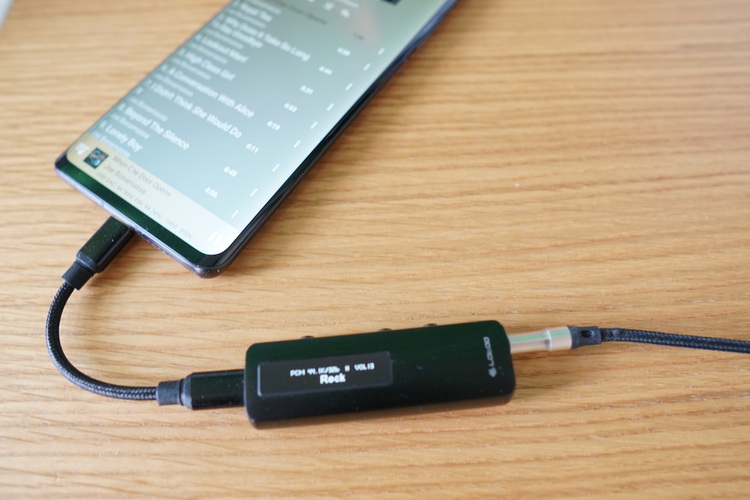
Some will wonder what the added value of a display on a device such as this is. And yes, it would indeed just be a gimmick if only the volume level and the quality of the audio stream would appear here. However, two buttons allow you to navigate through different equalizer / effects modes (EQ), which you can read on the display. That is handy. Not everyone likes EQ filters, but we found them well implemented here and therefore really contribute something. There are also some that make the listening experience sound through your headphones as through speakers. You don’t have to, but some prefer such a crossfeed view because it sounds more familiar.
The Lotoo PAW-S1 costs just under 180 euros and comes with a short USB-C to USB-C cable that you need for Android phones from around 2019. With this you can also connect the DAC to a new laptop. It also comes with an adapter plug to go from USB-C to the familiar USB-A, which is handy if you want to use it with an older laptop or desktop.
Using an AKM 4377-DAC chip, the PAW-S1 can handle hi-res to a high level (up to 32-bit / 384 kHz PCM and DSD128). Add to this a relatively powerful amplifier (70 mW at 320 Ohm) and you are talking about something small that can handle already ‘more difficult’ headphones. Quite surprising is that in addition to a classic 3.5 mm jack, Lotoo also provides a 4.4 mm Pentaconn connection. So you can also connect headphones or an in-ear in a balanced manner, an option that we have not seen before in this cheap segment. You may have to look for a 4.4-mm adapter, because there are really not many headphones that are equipped with this plug as standard.
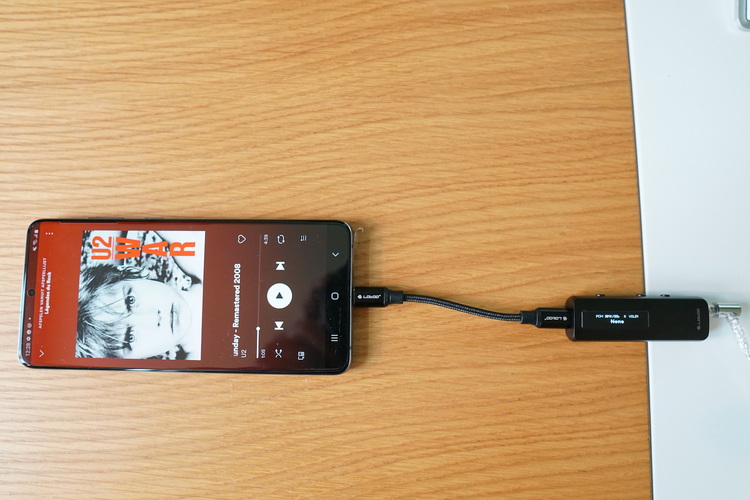
Despite its low price, the PAW-S1 is really a good performing device. The many EQ settings are partly a gimmick, but you can apply without your music being full of artifacts. Some, like ‘Headphone’ and ‘Nearfield’, we thought sounded nice at times. In any case, it is a smart addition to differentiate from most rivals. The PAW-S1 delivers – without EQ – a pleasant, mellow sound that also fits well with many headphones, including the Meze. We spontaneously reached for the discography of Tom Petty, vocal-driven songs like his flow really nicely from the combination Classic 99 and Lotoo. But also Antonio Sanchez’s great – well, if your inner drummer likes percussion – Birdman soundtrack came across as snappy and quick. The PAW-S1 is certainly not a lackluster amplifier, but we did notice that this album sounded a bit heavier with the TR-Amp. The Meze, like more headphones, performs better in the low end if there is more power.
Nice desktop solution
With the other two devices, we are particularly amazed by their small size and what they offer, with the TR-Amp there is rather an immediate feeling of satisfaction. For 279 euros, it is a beautifully finished thing that looks very solid and valuable. Pride of ownership is there for sure. The housing is made of brushed steel, in a beautiful red metal color, with a silver-colored knob that turns very nicely and with visible, sturdy bolts. On the bottom we read that it is a limited edition that fits a Meze Classic 99 headphones. In terms of technology, however, this special edition is no different from the regular one, it is more important that you can purchase the TR-Amp together with the Classic 99 at a good price.
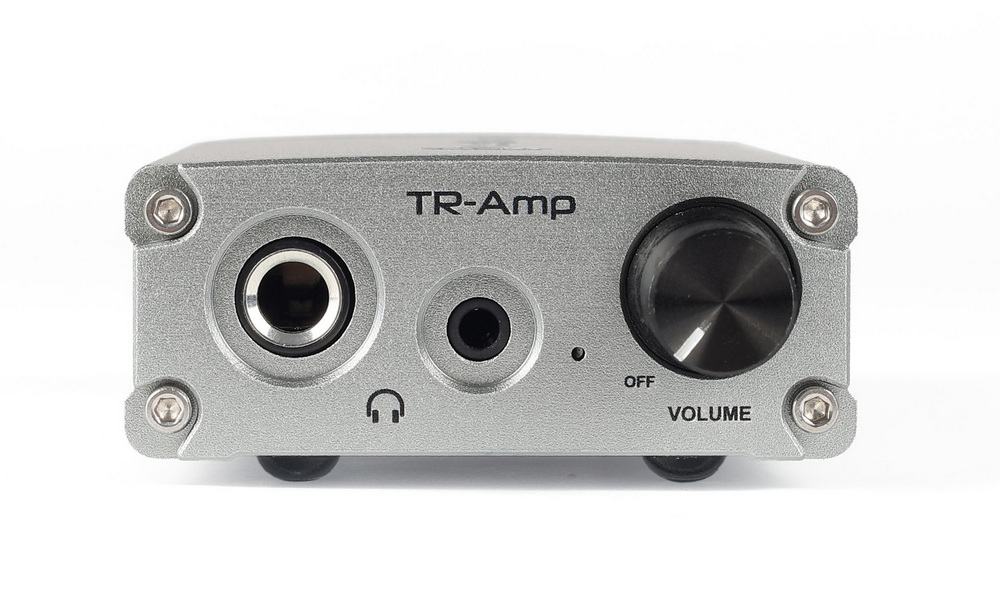
In theory you can connect the TR-Amp to a mobile device, but as mentioned, it is less likely in real-life circumstances. On the back you will find two USB-C connections: one for power, one for the data connection with your laptop or desktop PC. If you are concerned about malfunctions on a USB line: the DAC / amplifier actually gets its power from a built-in battery. When charged, you can also use the TR-Amp without a power cable. You can therefore take it with you in your backpack to listen to music somewhere at a flex desk. The battery lasts about ten hours, which is not bad.
At the back you spot a toggle switch to switch between pre-out or direct. This choice is available if you also use the TR-Amp to control a pair of speakers on your computer, via the cinch pair just next to it.
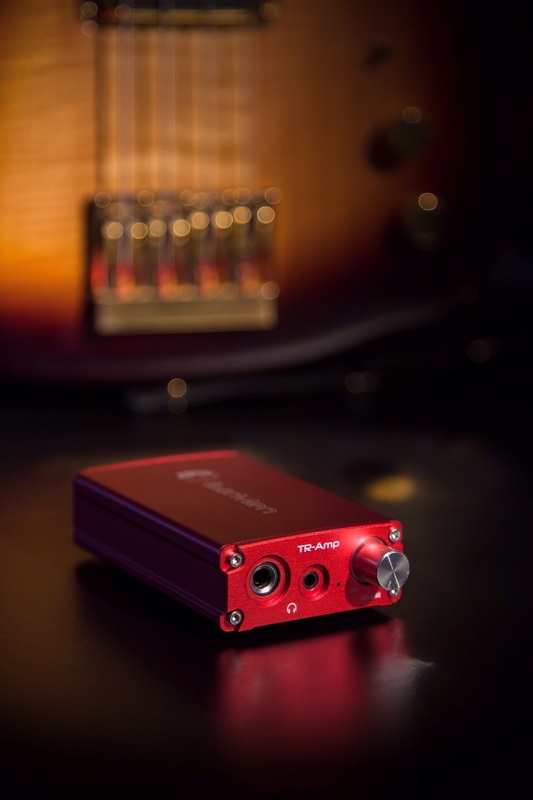
The Meze 99 and the EarMen amplifier are indeed a good match. The TR-Amp is not completely silent on very sensitive in-ears, but you will not notice anything at all on the Meze 99. The amplifier mainly has the power to propel the Romanian topper and also the resolution to counter the slightly dark side of the Meze. End result: a nice combination that works well with all genres, from ‘Fight The Power’ (an old Public Enemy track that never gets too old) to ‘Put Your Enemy on Me’ by the crazy Canadians of Arcade Fire. The Meze 99s remain closed headphones: useful if you do not want to disturb the environment / want to be disturbed, but you miss that spacious, large soundstage. But in their price range (and also just above it) the Meze 99s really do well, especially if you hang them on a slightly better amplifier such as this TR-Amp.
Options For Better Headphone Sound:Conclusion
Home workers and students will find in a DAC / amplifier like the three we looked at here one of the most accessible and at the same time best sound upgrades you can make. Of course, cheap depends on your situation, but for a modest expenditure you ensure a much better listening experience on your PC or mobile device.
The Looto PAW-S1 is the device that impressed the most. It is both for music lovers who are just looking for a quick fix and for audiophiles who like to tweak a little more. The PAW-S1 also sounds very nice and a bit laidback, which is ideal if you are busy messing around in Powerpoint. The Sparrow scores when you are looking for something you never have to think about again. And by that we mean just as well that you can place it discreetly at your workplace as the fact that the Sparrow has everything on board to let you listen to all possible formats, including MQA. The TR-Amp is the most expensive and least mobile of the trio. But it is the best all-rounder and the most powerful amplifier.





